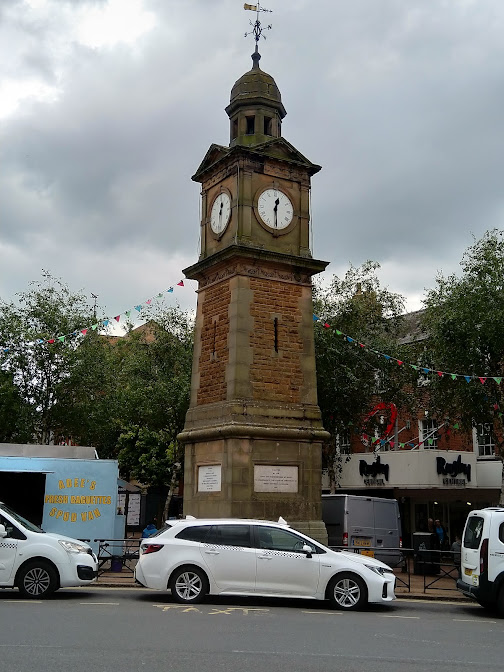We were off at our normal 09:30 and headed off. There were plenty of boats moving, one left at 06:30 from ahead of us. The managed to leave the mooring without colliding with me, unlike when they arrived.
The armada that protects the Clifton narrow boat base was not there today. We had seen a few around so was expecting there to be room to swing a windlass as we passed, and there was, but we didn't!
We didn't go very far to be honest as we stopped at the visitor moorings at Newbold. We had a bit of time to kill so we decided to catch the bus into Rugby for the afternoon.
The bus only takes a little over 15 minutes and dropped us at the Clock Tower. This was built to celebrate Queen Victoria's Diamond Jubilee in 1897. It was selected from eleven ideas of how to mark the celebration. A fund was raised and the building cost £500. It was designed by Goodacres of Leicester and built by Parnalls of Rugby. The base is made of grey granite and the tower of Derby Dale stone. It is partially filled with Northamptonshire iron stone. There is a clock face on each side. It has survived despite being lined up for demolition several times.
We walked to the south and came across the Rugby School buildings. These are almost the oldest parts of the school still existing. It is the Old Quad Buildings that date from between 1809 and 1813 and were designed by Henry Hakewill and there is a lot of detail in them. The school was started in 1567 as a part of a will of Lawrence Sheriff who left money for alms house and for a school for the local boys. Just before he died he reduced the money given to found the school, but added a bit of land he had. It turned out this was a good deal as it is now part of the Bloomsbury area in London. By the end of the 1600's children from all over the country attended the school. It was the Head Thomas Arnold (1828 to 1841)who really set the blue print for a Victorian Public School by his pushing of the moral and religious principals.
Of course the Town of Rugby and the school gave the name to the sport of rugby. Famously William Webb Ellis ran with the ball in 1823. He was a day pupil after his father was killed in the Peninsula Wars and his mother moved to Rugby so that he could come to the school. Apparently he was a good pupil and good at cricket. He went to oxford and then joined the church. He never married and ended up in Southern France. His grave was rediscovered in 1958 by Ross McWitter.
We had a turn round the Rugby Museum and Art gallery. Whilst interesting there is more to be found in our Hedon Museum.
The Temple Speech Room was opened on 3rd July 1909 and was named after Frederick Temple a former Headmaster. It was designed by Thomas Graham Jackson.
This building attracted me due to the 'chimney pots', if that is what they are as they may be ventilation flues, but they do stand out. This is Stanley House that currently is for 6th Form Boarders and was built in 1828 and became for girls in 1992.
This is the Geography Department down Horton Crescent. I liked the windows and the tower at the corner of the buildings, but especially that the windows at the bottom are at a slope.
We went round the little Webb Ellis Museum which is where Gilberts made the first rugby balls and they had some interesting stuff. We got a present for No.1 son too. The museum is free by the way.
I was struck by the fact that St. Andrew's, Rugby's parish church, has two towers. A church has been here since the time of Henry III (1216 - 1272). All that is left of that is the west tower (left in the above photo). The church was extensively rebuilt between 18798 and 1899 and the last bit to be added was the North East tower with a steeple top. I can't really remember a small church with both a tower and a steeple. They are doubly lucky as both towers have a full peel of bells and both are used for English change ringing.
Opposite where we caught the bus back to Newbold was this lovely brick carving. It was unveiled in 2000 and was by the artist John McKenna to celebrate Rugby's industrial heritage. You should be able to make out a cement works, a steam turbine generator that was made at the Willans works. There is also a Gloster Meteor jet fight which was the first British jet fighter. The jet was invented by Sir Frank Whittle in Rugby. Of course the canal features too.









No comments:
Post a Comment